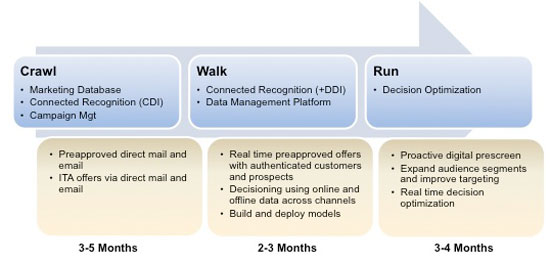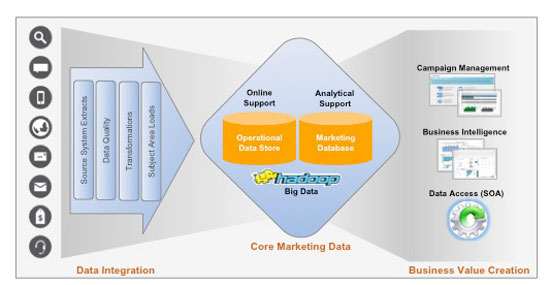Turn data hype into reality
How do you make Big Data and the rest a tool, not a dream?
- |
- Written by Jay Houghton, Merkle, Technology Services Group

Today’s bank marketer faces new wrinkles in the use and sourcing of data.
Increasingly, leveraging personalized experiences to attract new customers and to increase ability to cross sell, up sell, and retain existing customers is the only way to make the numbers.
Banks must begin to move the decision in the product vertical to the horizontal in environments that provide no single view of the customer’s conversion behaviors in the operational and analytical environments.
Nice theory, but how do you get it?
Such business challenges become technical challenges. In essence, the marketer must be able to reach customers across all channels with a singular and consistent message. To have a horizontal data view is to provide a means to see customers and prospects across products, channels, and time.
Lack of horizontal data means that most initiatives fail due to:
• Business and IT leaders who lose patience with long programs that don’t deliver.
• Impossibility for end users to determine requirements
• Dynamic business events that change requirements before the system is deployed.
• Inability to link to unstructured data.
With the rise of digital channels and growing insight from social media, the historical challenges of integrating across lines of business data and channel grow more complicated. Marketing data strategies must bridge the gap and provide a foundation for full integration. From the customer’s perspective, they must have a personalized experience across channels while maintaining continuity of messaging.
Banks must address these challenges and turn them into change. In order to positively impact business outcomes, we must focus on the following areas:
• Data quality is vital. In fact, the quality of your data is fundamental. The ability to effectively link data across the customer journey and channels is essential to gain insight and deliver a personalized experience.
• Inventory your data assets. Although a full data governance program is not necessary, it is important to know where your data resides, who is responsible for it, and what gaps exist.
• Link projects to business results. Align your investment in data and analytics to a hypothesis that has a positive business outcome.
• Make solid investments in technology. By starting small and having a program feel like a series of small projects all built to a common goal, you greatly increase chances of success.
• Integrate the process. Ensure tight integration of the technology stack to support the business across the lines of business and channels.
• Look to the future. By looking forward through predictive analytics, you will increase insight that will help pre-empt what the consumer may do next.
Making the strategy work
As we head down this journey or data strategy it is easiest to understand how to get there through a crawl, walk, and run analogy. The foundational component that the future state platform will be built on is the Next Generation Marketing Database.
Capabilities are layered upon it in order to address change and maturity in the business. As we see in the example below, we tie the technology roadmap with the required business capabilities, allowing for a solution that builds upon itself as the business requirements become more complex.
At the foundation of this approach is a solution that houses a rich 360-degree view of the consumer and their behaviors across channel and time. The primary capabilities required are solution that:
• Provides an integrated view of prospects and customers incorporating first-, second-, and third-party data sources.
• Stores complete historical event stream across traditional and digital channels.
• Enables real-time access to customer and prospect profiles.
• Provides a highly scalable, easily extendable, and self-documented system of record for all marketing activities.
There are three primary components that construct the solution: Data Integration, Core Marketing Data and Business Value Creation. We will review each of these components and its role.
Data Integration Layer …
… plays multiple roles within the architecture. Not only is it the mechanism for moving and loading our data, it provides the foundation that all data assets are built on. By deploying a component architecture for the data integration layer, we are to provide a highly scalable, re-usable, and extendable architecture.
What does this mean? We can move more data, at a higher quality, and with less effort and time. The components of the data integration layer are:
• Source system extracts—The means to get data out of systems to be consumed in both real time and batch. The raw data extracts should continue to flow through the other layers, but must also be archived with the big data layer for future analytics.
• Data quality—All data must pass through a series of technical and business data quality validations. These results must be captured over time and measured to ensure the continued advancement of business activities.
• Transformation—The data must be put into a format that is easily used by various downstream processes and semantically cleansed to ensure integration of disparate sources.
• Subject area loads —By grouping our data and loading it by subject area, we are able to simplify the process and allow for easy integration to the downstream targets in the core marketing data layer.
Core Marketing Data Layer …
… is where data is assembled for downstream consumption. This layer differs from the traditional marketing database in that it accommodates three distinct data stores as opposed to just the traditional single Relational Database Management System (RDBMS).
The three layers each serve distinct functions in support of the roadmap defined above. They include:
• Operational Data Store—A highly scalable database designed to allow for rapid access to information to be used in real time. This differs from the core marketing database as it is designed for sparse data lookups such as those required to provide sub-second response times for online offers.
• Marketing Database—The primary store of historical marketing data, structured to promoted easy access for campaign management, reporting, and analytics. The marketing database is primarily used for offline activities.
• Big Data—A singular platform that will store all raw data; cleansed data that has passed through the data integration layer in the form of subject area files; and un-structured data not suitable for a traditional RDBMS.
This platform will serve as the primary means to gain insight about the data that was never possible with a traditional marketing database platform.
Business Value Creation …
…is the culmination of the many pieces that went into the solution and their measurable outcome on the business performance. In summary we have addressed:
• Resolution of data quality though our data integration layer.
• We inventoried our data assets within the core marketing data layer.
• We ensured tight integration of our solution through a component architecture that aligned to business capabilities.
• We made a solid investment in our marketing technology through a crawl, walk, run deployment.
• Linked that technology investment to business outcomes.
• Now we just need to look to the future … we have established the data assets and core infrastructure to get ahead of the consumer and pre-empt what they will do next.
In conclusion, the ability to view horizontal data requires a much more sophisticated and modern architecture than the traditional marketing database. This foundation will allow you to scale your marketing efforts and provide a means for higher return on investment.
About the author
Jay Houghton is senior vice-president, technology services group, at Merkle. The group focuses on implementations of marketing analytic platforms, providing a foundational approach to marketing data management and analytics. Prior to joining Merkle, Houghton headed the technology and data practice for public sector clients at IBM. In addition, he provided the technical leadership for IBM’s cross-industry group, which included redefining the common approach for analytical environments into a more modern method focused on Big Data capabilities and time-to-value of data.
Tagged under Retail Banking, Technology, CSuite, Big Data, Feature, Feature3,















